Unit 5 Buying and Selling.Lesson 29 How to Push a Product.课件
文档属性
| 名称 | Unit 5 Buying and Selling.Lesson 29 How to Push a Product.课件 | 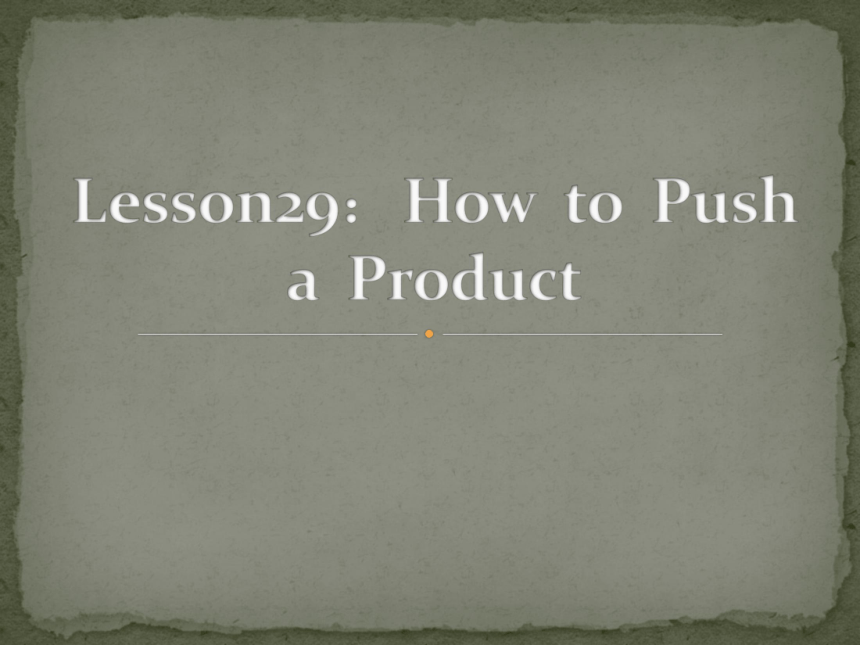 | |
| 格式 | zip | ||
| 文件大小 | 2.3MB | ||
| 资源类型 | 教案 | ||
| 版本资源 | 冀教版 | ||
| 科目 | 英语 | ||
| 更新时间 | 2018-04-09 12:53:35 | ||
图片预览

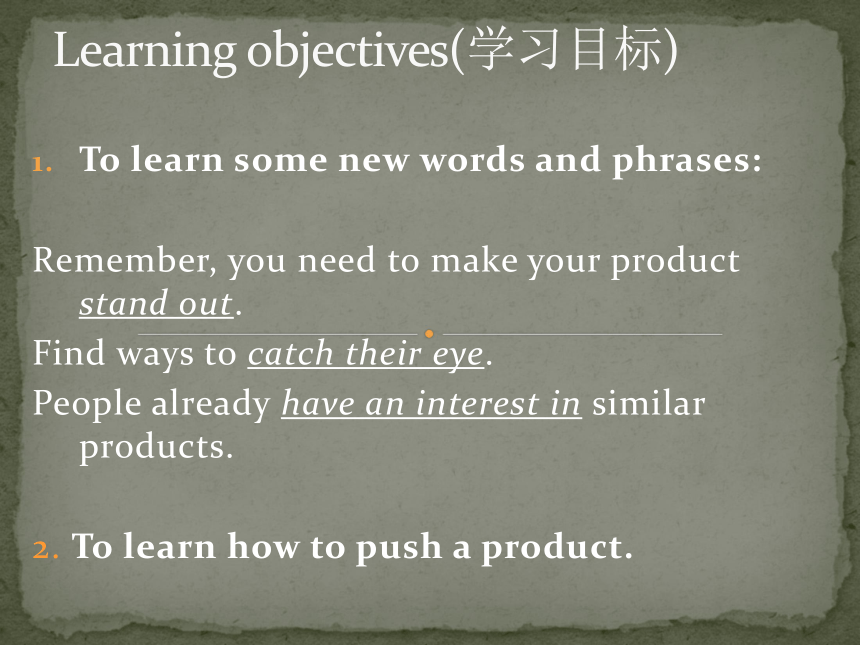
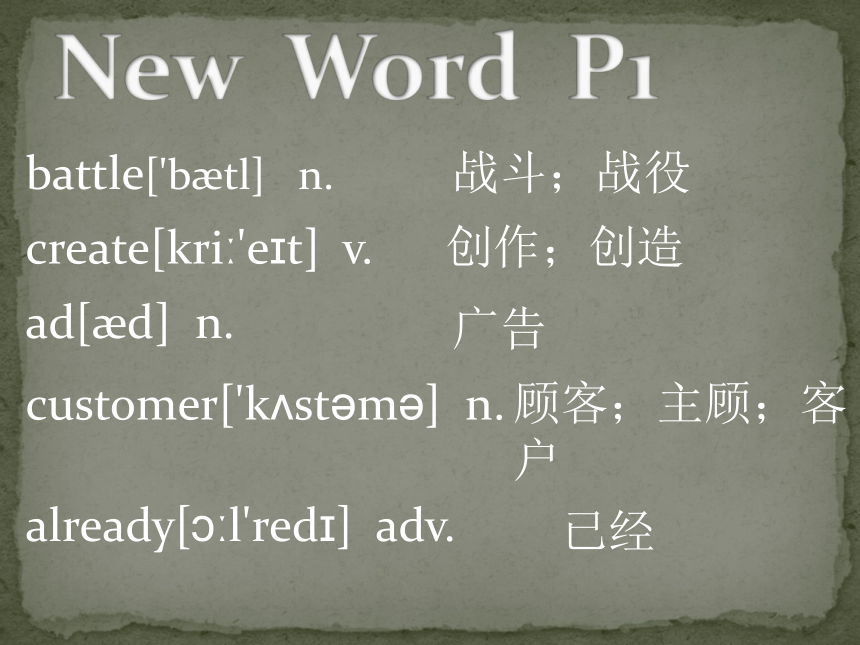
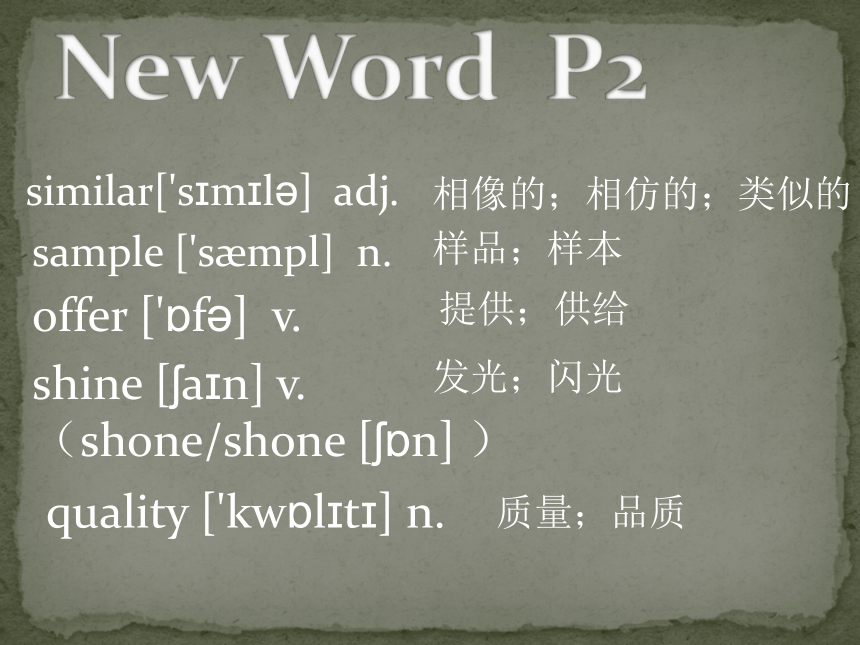
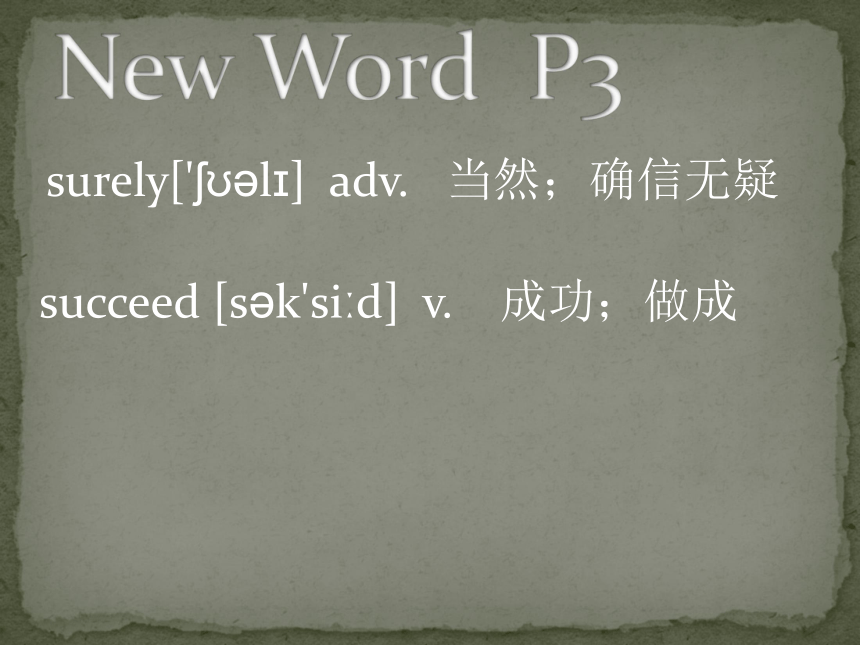
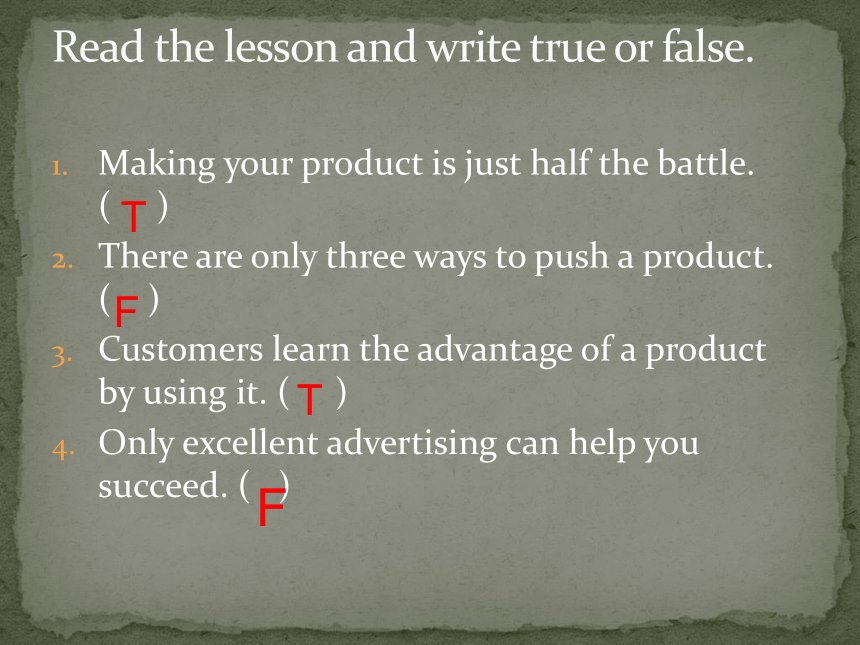

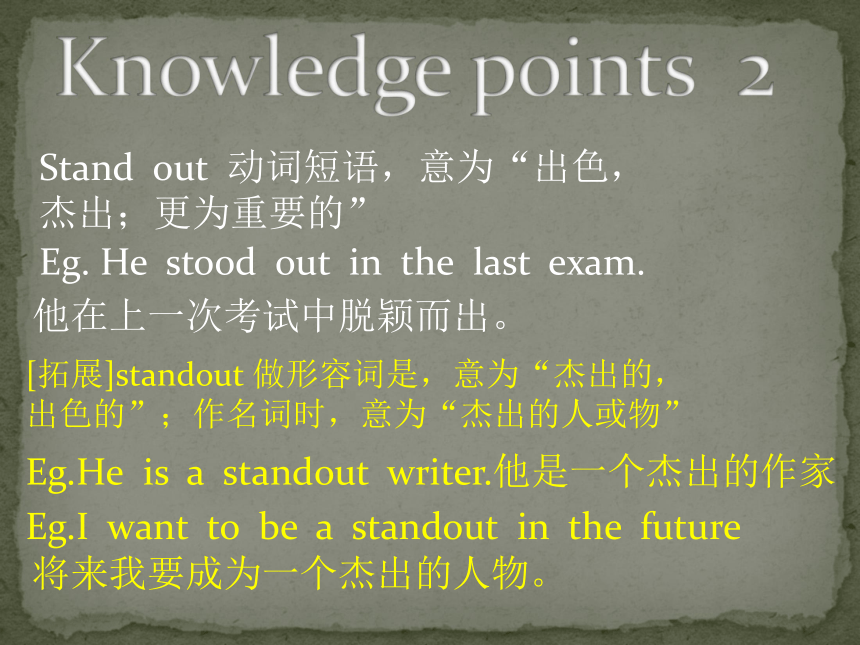
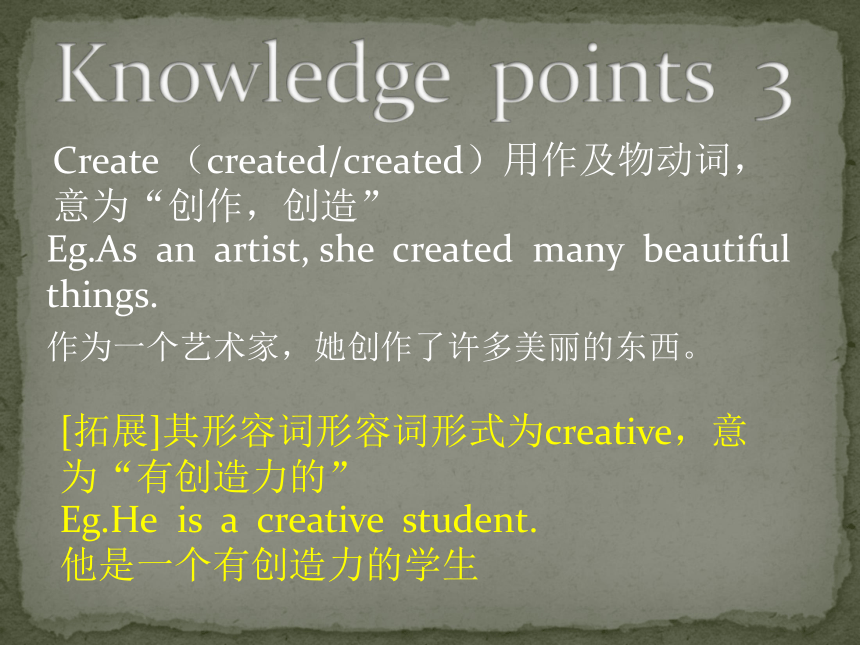
文档简介
课件21张PPT。Lesson29:How to Push a ProductLearning objectives(学习目标)To learn some new words and phrases:
Remember, you need to make your product stand out.
Find ways to catch their eye.
People already have an interest in similar products.
2. To learn how to push a product.New Word P1battle['b?tl] n. create[kri?'e?t] v.ad[?d] n.customer['k?st?m?] n.already[??l'red?] adv.战斗;战役创作;创造广告顾客;主顾;客户已经New Word P2相像的;相仿的;类似的sample ['s?mpl] n.offer ['?f?] v.shine [?a?n] v.(shone/shone [??n] )quality ['kw?l?t?] n.similar['s?m?l?] adj.样品;样本提供;供给发光;闪光质量;品质New Word P3surely['???l?] adv.succeed [s?k'si?d] v.当然;确信无疑成功;做成Read the lesson and write true or false.Making your product is just half the battle. ( )
There are only three ways to push a product. ( )
Customers learn the advantage of a product by using it. ( )
Only excellent advertising can help you succeed. ( )TFTFKnowledge points 1Eg.A man is pushing an interesting product.
一个人正在推销有趣的产品。
Push a product 意为“推销产品”Knowledge points 1Knowledge points 2Stand out 动词短语,意为“出色,杰出;更为重要的”Eg. He stood out in the last exam.[拓展]standout 做形容词是,意为“杰出的,出色的”;作名词时,意为“杰出的人或物”Eg.He is a standout writer.他是一个杰出的作家 他在上一次考试中脱颖而出。Eg.I want to be a standout in the future将来我要成为一个杰出的人物。Knowledge points 3Create (created/created)用作及物动词,意为“创作,创造”Eg.As an artist, she created many beautiful things.作为一个艺术家,她创作了许多美丽的东西。[拓展]其形容词形容词形式为creative,意为“有创造力的”
Eg.He is a creative student.
他是一个有创造力的学生Knowledge point 4Catch one’s eye 意为“吸引某人的目光”,其中eye常用单数形式。同义词组为draw one’s attentionEg.Lots of things can catch our eye.
许多东西都能吸引我们的目光。Knowledge point 5Already用作副词,意为“已经”,通常在实义动词之前,连系动词be/助动词/情态动词之后。一般用于肯定句。注意:already用于疑问句时表惊讶,多在句尾。Eg.This man is already 90-year-old.这个男人已经90岁了。Have you done your homework already? You’re so speedy. 你已经完成作业了吗?你的速度真快。Knowledge point 6have an interest in….意为“对…..有兴趣”,后接名称,代词或动名词。其中interest用作名词意为“兴趣”。eg.I have an interest in history.我对历史感兴趣。be interested in…Knowledge point 7Offer此处用作及物动词,意为“提供”,其后可跟名词或代词作宾语,也可跟双宾语, “为某人提供某物”:offer sb sth =offer sth to sb【拓展】offer to do sth 表示“主动提出做某事”。eg.She offered to lend me her dictionary.她主动提出将她的词典借给我。Knowledge point 7【拓展2】offer与provide都可用作动词,都有“提供;供给”之意,但在用法上不同Knowledge point 7.5(接上)eg.At the party, he offered me a glass of wine.在宴会上,他主动递给我一杯鸡尾酒。eg.The school provides food and fruit for the students.这个学校为学生提供食物和水果。Knowledge point 8Succeed此处用作不及物动词,意为“成功,做成”,常用结构:
succeed (in) doing sth.做某事成功; succeed with sth.在某方面成功。【拓展】反义词为fail(动词)。
名词success(成功);
形容词successful(成功的);
副词successfullyRead and find out the topic sentences of paragraph3,4,5.Paragraph 3
Paragraph4
Paragraph5Create an ad.Go to trade shows and present your product.Push your product using samples and good deals.Exercise It’s not easy to make your product succeed. Because there are always _______ products on the market, you have to put in more effort. You should choose specific _____, then create a perfect ad to ____________. When they buy your product, ______ them good service. Remember, _______ advertising will always make your product _______. similarofferstand outcustomerscatch their eyeexcellentHomework:
Push the ipad proPractice time1.Has he finished his work ______?
A.already B.yet C.readyA2.He ______ the story last week
A.create B. creative C.createdCThis cloth catch my eye.(改为同义句)
This cloth ____ ____ ____.darw my eyeThank you for watching
Remember, you need to make your product stand out.
Find ways to catch their eye.
People already have an interest in similar products.
2. To learn how to push a product.New Word P1battle['b?tl] n. create[kri?'e?t] v.ad[?d] n.customer['k?st?m?] n.already[??l'red?] adv.战斗;战役创作;创造广告顾客;主顾;客户已经New Word P2相像的;相仿的;类似的sample ['s?mpl] n.offer ['?f?] v.shine [?a?n] v.(shone/shone [??n] )quality ['kw?l?t?] n.similar['s?m?l?] adj.样品;样本提供;供给发光;闪光质量;品质New Word P3surely['???l?] adv.succeed [s?k'si?d] v.当然;确信无疑成功;做成Read the lesson and write true or false.Making your product is just half the battle. ( )
There are only three ways to push a product. ( )
Customers learn the advantage of a product by using it. ( )
Only excellent advertising can help you succeed. ( )TFTFKnowledge points 1Eg.A man is pushing an interesting product.
一个人正在推销有趣的产品。
Push a product 意为“推销产品”Knowledge points 1Knowledge points 2Stand out 动词短语,意为“出色,杰出;更为重要的”Eg. He stood out in the last exam.[拓展]standout 做形容词是,意为“杰出的,出色的”;作名词时,意为“杰出的人或物”Eg.He is a standout writer.他是一个杰出的作家 他在上一次考试中脱颖而出。Eg.I want to be a standout in the future将来我要成为一个杰出的人物。Knowledge points 3Create (created/created)用作及物动词,意为“创作,创造”Eg.As an artist, she created many beautiful things.作为一个艺术家,她创作了许多美丽的东西。[拓展]其形容词形容词形式为creative,意为“有创造力的”
Eg.He is a creative student.
他是一个有创造力的学生Knowledge point 4Catch one’s eye 意为“吸引某人的目光”,其中eye常用单数形式。同义词组为draw one’s attentionEg.Lots of things can catch our eye.
许多东西都能吸引我们的目光。Knowledge point 5Already用作副词,意为“已经”,通常在实义动词之前,连系动词be/助动词/情态动词之后。一般用于肯定句。注意:already用于疑问句时表惊讶,多在句尾。Eg.This man is already 90-year-old.这个男人已经90岁了。Have you done your homework already? You’re so speedy. 你已经完成作业了吗?你的速度真快。Knowledge point 6have an interest in….意为“对…..有兴趣”,后接名称,代词或动名词。其中interest用作名词意为“兴趣”。eg.I have an interest in history.我对历史感兴趣。be interested in…Knowledge point 7Offer此处用作及物动词,意为“提供”,其后可跟名词或代词作宾语,也可跟双宾语, “为某人提供某物”:offer sb sth =offer sth to sb【拓展】offer to do sth 表示“主动提出做某事”。eg.She offered to lend me her dictionary.她主动提出将她的词典借给我。Knowledge point 7【拓展2】offer与provide都可用作动词,都有“提供;供给”之意,但在用法上不同Knowledge point 7.5(接上)eg.At the party, he offered me a glass of wine.在宴会上,他主动递给我一杯鸡尾酒。eg.The school provides food and fruit for the students.这个学校为学生提供食物和水果。Knowledge point 8Succeed此处用作不及物动词,意为“成功,做成”,常用结构:
succeed (in) doing sth.做某事成功; succeed with sth.在某方面成功。【拓展】反义词为fail(动词)。
名词success(成功);
形容词successful(成功的);
副词successfullyRead and find out the topic sentences of paragraph3,4,5.Paragraph 3
Paragraph4
Paragraph5Create an ad.Go to trade shows and present your product.Push your product using samples and good deals.Exercise It’s not easy to make your product succeed. Because there are always _______ products on the market, you have to put in more effort. You should choose specific _____, then create a perfect ad to ____________. When they buy your product, ______ them good service. Remember, _______ advertising will always make your product _______. similarofferstand outcustomerscatch their eyeexcellentHomework:
Push the ipad proPractice time1.Has he finished his work ______?
A.already B.yet C.readyA2.He ______ the story last week
A.create B. creative C.createdCThis cloth catch my eye.(改为同义句)
This cloth ____ ____ ____.darw my eyeThank you for watching
同课章节目录
- Unit 1 Spring Is Coming
- Lesson 1 How's the weather?
- Lesson 2 It's Getting Warmer!
- Lesson 3 Sun Is Rising
- Lesson 4 The Spring City
- Lesson 5 Babysitting on a Spring Day
- Lesson 6 Stories about Spring
- Unit 2 Plant a Plant
- Lesson 7 Planting Trees
- Lesson 8 Why Are Plants Important?
- Lesson 9 Gardening with Mary
- Lesson 10 Make Your Garden Grow!
- Lesson 11 Amazing Plants
- Lesson 12 Danny's Plant
- Unit 3 Animals Are Our Friends
- Lesson 13 Danny's Big Scare
- Lesson 14 Amazing Animals
- Lesson 15 The Zoo Is Open
- Lesson 16 The Pear Escaped
- Lesson 17 Save the Tigers
- Lesson 18 Friendship Between Animals
- Unit 4 The Internet Connects Us
- Lesson 19 How Do You Use the Internet?
- Lesson 20 A Computer Helps!
- Lesson 21 Books or Computers?
- Lesson 22 Travel on the Internet
- Lesson 23 The Internet--Good or Bad?
- Lesson 24 An E-mail to Grandpa
- Unit 5 Buying and Selling
- Lesson 25 Raising Money
- Lesson 26 Cookies, Please!
- Lesson 27 Business English
- Lesson 28 Ms. Liu's Great Idea
- Lesson 29 How to Push a Product
- Lesson 30 A Cookie Sale
- Unit 6 Be a Champion!
- Lesson 31 Don't Fall, Danny
- Lesson 32 My Favourite Record
- Lesson 33 2800 Years of Sports
- Lesson 34 Modern Olympics
- Lesson 35 The Dream Team
- Lesson 36 Classroom Olympics
- Unit 7 Know Our World
- Lesson 37 Let's Learn Geography!
- Lesson 38 The World Is a Big Place
- Lesson 39 Ring Up or Call?
- Lesson 40 Body Language
- Lesson 41 A Class of the World
- Lesson 42 North America
- Unit 8 Save Our World
- Lesson 43 Let's Clean Up!
- Lesson 44 Environment Clubs
- Lesson 45 Let's Sort Garbage!
- Lesson 46 Protect Our Environment
- Lesson 47 Connected to Nature
- Lesson 48 Garbage Is Interesting!
